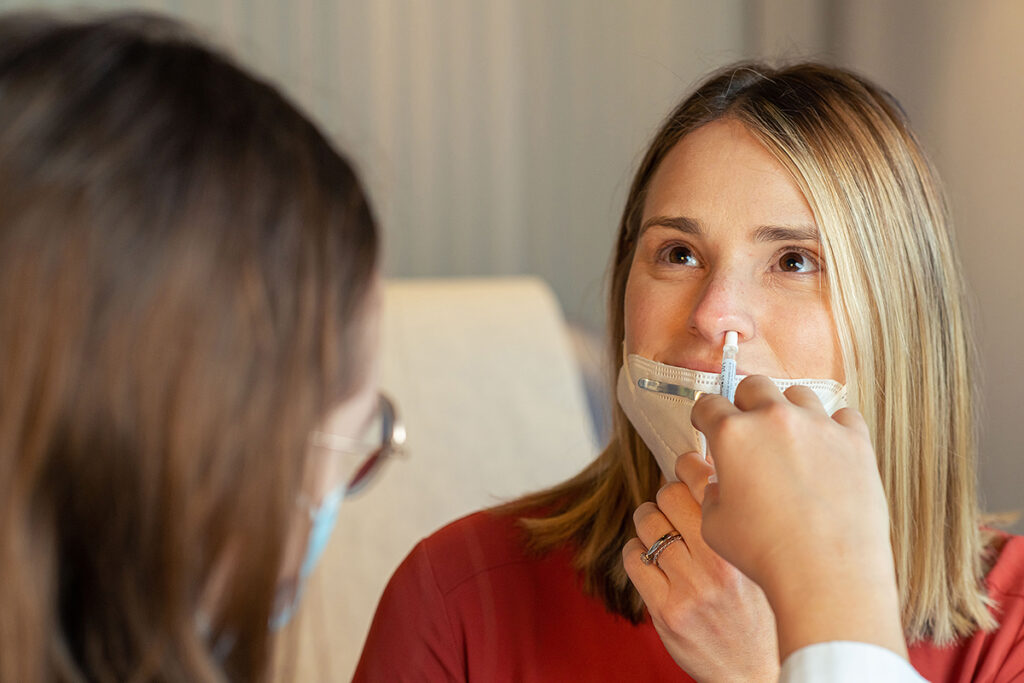Researchers at the Center for Virology, Vaccinology, and Therapy in Hong Kong, China, have developed a nasal coronavirus vaccine that could become a new pan-coronavirus vaccine. This vaccine contains a live attenuated SARS-CoV-2 virus with a modified genome. Firstly, this virus cannot replicate in the body as it does not produce new viral particles. Secondly, the virus generates interferon-beta (IFN-beta). The vaccine is named IBIS, short for Interferon-Beta Integrated SARS-CoV-2.
The nasal vaccine has the potential to protect against various coronavirus strains. It is administered directly to the respiratory tract, stimulating mucosal immunity, which is one of the routes through which the coronavirus enters the body. Nasal vaccination mimics natural infection, triggering protective B-cell and T-cell responses. Moreover, the weakened virus used in the vaccine expresses several viral proteins, including the spike protein. Viral proteins induce an adaptive immune response, reacting to protein fragments shared among different coronaviruses.
The weakened coronavirus in the nasal vaccine does not cause infection but initiates an immune response in the mucous membranes. To ensure sufficient virus attenuation and prevent its ability to regain virulence, Chinese scientists modified the virus’s genome to enable it to produce interferon type I.
Interferons type I, and III are molecules fundamental to the innate antiviral defense. Their production increases when the virus enters the body. Interferons inhibit virus replication in infected cells and shield neighboring healthy cells from infection. Furthermore, type I interferons, produced by infected cells, activate adaptive immunity and contribute to the formation of effector T-cells and memory T-cells, protecting the body from reinfection.
The coronavirus delays the production of interferon type I, disrupting the T-cell response to the virus. Therefore, scientists added the ability to produce IFN-beta to the vaccine. As a result, IBIS nasal vaccination mimics natural infection but with a timely interferon response. Additionally, IFN-beta enhances vaccine safety and acts as protection against co-infections.
Administering the nasal vaccine IBIS leads to interferon production. Therefore, IBIS contributes to an optimal adaptive immune response to the coronavirus. Compared to a vaccine without interferon, IBIS not only initiates a robust killer T-cell response in the lungs but also intensifies the activation of virus-specific helper T-cells in the mucous membrane – cells that enhance the activity of other immune cells.
In the fall of 2023, IBIS is undergoing preclinical trials involving animals and cell cultures.
IBIS Nasal Vaccine Offers Protection Against Lethal Coronavirus Infection
A mouse study showed that IBIS induced the production of neutralizing antibodies in all vaccinated mice 14 days after the first IBIS dose. The second dose administered on the 14th day increased the titer of neutralizing antibodies by 100-fold. The high level of IgG antibodies to the RBD was comparable to antibody levels after two doses of the Pfizer-BioNTech mRNA vaccine. However, IBIS induced the production of neutralizing antibodies against both the spike protein and the nucleoprotein of the coronavirus, whereas mRNA vaccines do not elicit antibodies against the nucleoprotein as they encode only the spike protein.
The weakened coronavirus present in the vaccine could not replicate. Two days after IBIS administration to the lungs of mice, no virus particles were detected. IBIS did not cause weight loss or COVID-19 symptoms and did not initiate the production of the inflammatory cytokine TNFα or lung damage.
After 28 days of vaccinating the mice, they were infected with a lethal dose of the ancestral SARS-CoV-2 strain. On the second day after infection, no viral particles were detected in the lungs of vaccinated mice. All mice immunized with IBIS survived and maintained their original body weight.
IBIS Nasal Vaccine Prevents Coronavirus Transmission
A study conducted on hamsters involved the vaccination of these animals with two doses of IBIS, administered 14 days apart. Afterwards, they were housed together with hamsters infected with the coronavirus.
Similar to mice, IBIS triggered a robust antibody response in vaccinated hamsters against both the spike protein of the coronavirus and the nucleoprotein. The second vaccine dose, given on the 14th day, elevated the titer of neutralizing antibodies by 10-100 times.
The IBIS nasal vaccine shielded hamsters from coronavirus infection. After cohabitation with infected hamsters, the vaccinated hamsters maintained their body weight, whereas the unvaccinated hamsters lost over 10% of their body weight. In both the lungs and nasal passages of the vaccinated hamsters, no coronavirus was detected, while unvaccinated hamsters had a high viral titer already on the second day after cohabitation with the infected hamsters. Vaccination protects hamsters from lung damage after cohabitation with infected hamsters.
IBIS Vaccine Prevents Infection by SARS-CoV-2 Variants Delta and Omicron, as well as Protects Against SARS-CoV-1
Studies on both mice and hamsters revealed that no coronavirus from the Delta or Omicron strains was detected in the lungs on the second or fifth day after infection. IBIS also effectively protected against Omicron subvariants: Stealth, BA.4.1, and BA.5.2, reducing the viral titer in the lungs to an undetectable level. IBIS vaccination prevented the transmission of Delta and Omicron strains during cohabitation between vaccinated and infected hamsters.
IBIS shielded mice from a lethal SARS-CoV-1 infection. After infection with SARS-CoV-1, all IBIS-vaccinated mice survived and maintained their weight, whereas unvaccinated mice lost over 10% of their body weight and succumbed to the disease. In vaccinated mice, IBIS reduced the viral titer in the lungs and nasal passages to an undetectable level on the fifth day after infection. Similar results were observed in hamsters.
Conclusion
The IBIS vaccine contains a genetically modified coronavirus that produces IFN-beta, lacks a viral envelope, and cannot replicate. IFN-beta activates the innate antiviral response, suppresses co-infection with other SARS-CoV-2 strains, and additionally safeguards against the proliferation of the coronavirus present in the vaccine.
T-cell immunity plays a pivotal role in combating coronavirus infection. The coronavirus suppresses the type I interferon response, disrupting T-cell responses. Restoring an early type I interferon response eases the course of the disease. IFN-beta produced upon IBIS vaccine administration enhances mucosal immunity through optimal activation of antigen-specific T-helper cells, amplifying the activity of other immune cells.
The IBIS vaccine inhibits SARS-CoV-2 Omicron and Delta strains, as well as SARS-CoV-1. The IBIS nasal vaccine, containing a weakened SARS-CoV-2 virus that produces interferon-beta, has the potential to become a pan-coronavirus vaccine.
Useful article, necessary information? Share it!
Someone will also find it useful and necessary:
Reference
An interferon-integrated mucosal vaccine provides pan-sarbecovirus protection in small animal models



